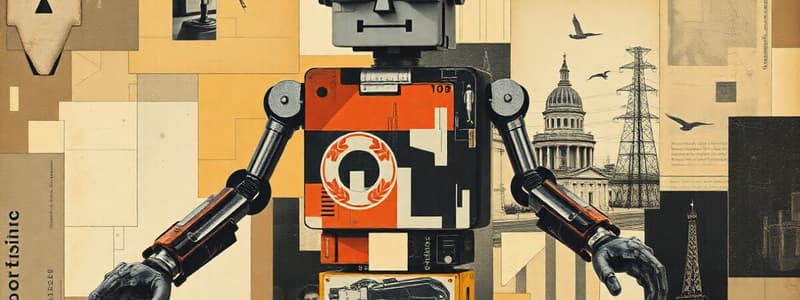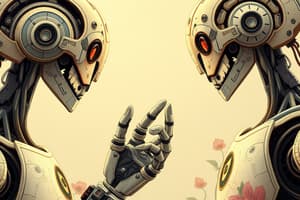Podcast
Questions and Answers
Which feature allows Honda's ASIMO to function effectively as a personal assistant?
Which feature allows Honda's ASIMO to function effectively as a personal assistant?
- Ability to play chess
- Capability of flying
- Ability to skate on ice
- Recognition of face, voice, and name (correct)
What was a significant application of iRobot Packbots after their initial use at the World Trade Center?
What was a significant application of iRobot Packbots after their initial use at the World Trade Center?
- Military operations in Afghanistan and Iraq (correct)
- Assisting in industrial assembly
- Participating in robotics competitions
- Exploring Mars
What key advantage does the development of AI bring to the industrial sector?
What key advantage does the development of AI bring to the industrial sector?
- Improved decision making and predictive maintenance (correct)
- Decreased manufacturing costs
- Faster assembly times
- Increased emotional intelligence
What distinguishes the Sony Dream Robots (SDR) in terms of interaction?
What distinguishes the Sony Dream Robots (SDR) in terms of interaction?
What was the primary goal of the robotic rovers Spirit and Sojourner launched by NASA?
What was the primary goal of the robotic rovers Spirit and Sojourner launched by NASA?
What future challenge must robots overcome to become truly useful in everyday life?
What future challenge must robots overcome to become truly useful in everyday life?
Which company was involved in creating a robotic system for assembling the International Space Station?
Which company was involved in creating a robotic system for assembling the International Space Station?
What kind of advancements in robotics does the future predict regarding machine capabilities?
What kind of advancements in robotics does the future predict regarding machine capabilities?
Which technology was launched to help provide domestic and professional robot solutions in society?
Which technology was launched to help provide domestic and professional robot solutions in society?
Which feature of robots is seen as crucial in improving their function according to the content?
Which feature of robots is seen as crucial in improving their function according to the content?
What is the primary focus of robotics as a field of study?
What is the primary focus of robotics as a field of study?
In which year did Isaac Asimov introduce the term 'Three Laws of Robotics'?
In which year did Isaac Asimov introduce the term 'Three Laws of Robotics'?
Who first used the term 'robot' in literature?
Who first used the term 'robot' in literature?
Which of the following statements aligns with one of Asimov's Three Laws of Robotics?
Which of the following statements aligns with one of Asimov's Three Laws of Robotics?
Which ancient engineer is credited with creating early automated devices?
Which ancient engineer is credited with creating early automated devices?
What was the significance of the first industrial robot activated in 1961?
What was the significance of the first industrial robot activated in 1961?
Which robot developed in the 1960s is known for incorporating both tactile sensors and a vision camera?
Which robot developed in the 1960s is known for incorporating both tactile sensors and a vision camera?
In 'Frankenstein', what concept about artificial life does Mary Shelley explore?
In 'Frankenstein', what concept about artificial life does Mary Shelley explore?
Which influential work published in 1948 significantly impacted artificial intelligence research?
Which influential work published in 1948 significantly impacted artificial intelligence research?
What key advancement occurred at MIT in 1959 related to robotics?
What key advancement occurred at MIT in 1959 related to robotics?
What component of a robot mimics the function of human muscles to enable movement?
What component of a robot mimics the function of human muscles to enable movement?
Which part of a robot is primarily responsible for interpreting data from sensors?
Which part of a robot is primarily responsible for interpreting data from sensors?
What type of power source is typically used for robots that require mobility?
What type of power source is typically used for robots that require mobility?
Which of the following is a function of sensors in robots?
Which of the following is a function of sensors in robots?
What defines a device as a robot regarding its physical capabilities?
What defines a device as a robot regarding its physical capabilities?
What is the role of end effectors in a robot?
What is the role of end effectors in a robot?
In robotic systems, what major function do light-dependent resistors primarily serve?
In robotic systems, what major function do light-dependent resistors primarily serve?
Which part of a robot is mainly responsible for receiving feedback and functioning similarly to the human brain?
Which part of a robot is mainly responsible for receiving feedback and functioning similarly to the human brain?
Which of the following statements accurately describes a control system in a robot?
Which of the following statements accurately describes a control system in a robot?
What distinguishes the central processing unit (CPU) in a robot from a human brain?
What distinguishes the central processing unit (CPU) in a robot from a human brain?
What was a pioneering achievement of Al-Jazari in the field of robotics?
What was a pioneering achievement of Al-Jazari in the field of robotics?
Which milestone defines the moment when the term 'robot' was first introduced to society?
Which milestone defines the moment when the term 'robot' was first introduced to society?
Flashcards are hidden until you start studying
Study Notes
Overview of Robotics
- Robotics integrates multiple fields: electronic engineering, mechanical engineering, and computer science.
- Focuses on design, construction, control of robots, and sensory feedback.
Historical Milestones
- 270 BC: Ctesibius engineered movable figures and water clocks in ancient Greece.
- 1818: Mary Shelley published "Frankenstein," depicting artificial life.
- 1921: Karel Capek introduced the term "robot" in the play "R.U.R." (Rossum's Universal Robots).
- 1942: Isaac Asimov wrote "Runaround," establishing the "Three Laws of Robotics."
- 1948: Norbert Wiener published "Cybernetics," influencing AI research.
- 1956: George Devol and Joseph Engerberger founded the first robot company in New Jersey.
- 1959: MIT showcased computer-assisted manufacturing innovations.
- 1961: The Unimate became the first industrial robot activated in General Motors’ assembly line.
- 1960s: SHAKY, a mobile robot with tactile sensors and vision capabilities, was developed.
- 1970s: NASA created the MARS-ROVER for exploring hostile terrains, featuring an integrated mechanical arm.
- 1980s and 1990s: Significant advancements in artificial intelligence were made, enhancing robotics in industry with benefits like improved accuracy and predictive maintenance.
- 2000: Sony introduced SDR, capable of face recognition, emotional expression, and navigating various surfaces.
- 2001: iRobot Packbots served in search operations post-9/11 and were used in military settings; NASA built the SSRMS for the International Space Station.
- 2002: Honda launched ASIMO, designed as a personal assistant with advanced recognition features.
- 2003: NASA launched Mars rovers Spirit and Sojourner to explore the surface of Mars; RobotShop was established to enhance societal engagement with robot technology.
Future of Robotics
- Robots must achieve greater self-sufficiency for practical utility.
- Advances in AI are crucial for enabling robots to learn autonomously, adapting to various tasks and environments.
Overview of Robots
- Robots are machines that operate automatically, capable of adapting to environmental changes.
- Essential components of a robot include a control system, sensors, actuators, power supply, and end effectors.
Control System
- Functions similarly to the human brain, using feedback for decision-making.
- Composed of a central processing unit (CPU) instead of neurons.
- The CPU processes data collected from various sensors.
Sensors
- Provide feedback by mimicking human senses, facilitating interaction with the environment.
- Common types include:
- Video cameras for visual input, similar to human eyes.
- Light-dependent resistors and microphones acting like auditory receptors (ears).
- Some advanced robots also have capabilities for touch, taste, and smell.
- The CPU interprets sensor signals and adjusts actions accordingly.
Actuators
- Actuators function like human muscles, enabling movement of the robot's body based on sensor feedback.
- They play a crucial role in physical interaction with the environment.
Power Supply
- Majority of robots are powered by electricity.
- Stationary robots, like those in manufacturing, can be directly plugged in.
- Mobile robots often operate on battery power for mobility and flexibility.
End Effectors
- Equipped with specific tools called end effectors that vary depending on the intended tasks.
- The design of end effectors is essential for the robot to perform its designated functions effectively.
Ancient Automata
- 3rd Century BC: Archytas of Tarentum created a wooden dove powered by steam, marking an early example of automata.
- 1206: Al-Jazari designed a water-powered alarm clock that included automata, showcasing advanced engineering for its time.
20th Century Foundations
- 1921: Karel Čapek's play "R.U.R." introduced the term "robot," highlighting the cultural impact of artificial beings in literature.
- 1942: Isaac Asimov's "Three Laws of Robotics" established ethical frameworks for robots, influencing future robotic theory and legislation.
Early Mechanical Robots
- 1950s: George Devol invented "Unimate," the first industrial robot tailored for manufacturing, paving the way for automation in industry.
- 1961: Unimate made its debut in General Motors, revolutionizing production line efficiency.
Advancements in AI and Robotics
- 1970s: The development of AI and new programming languages yielded robots like Shakey, which demonstrated advanced navigation and decision-making.
- 1980s: The introduction of microprocessors led to complex robotics and expanded automation capabilities.
Modern Robotics
- 1996: Honda's ASIMO showcased significant advancements in humanoid robotics, being able to walk and climb stairs.
- 2000s: Integration of AI into robotic systems enhanced capabilities in areas such as speech recognition and environment interaction.
Current Trends
- 2010s-Present: The rise of collaborative robots (cobots) designed to safely work alongside humans in various sectors.
- Ongoing improvements in machine learning, sensor technology, and artificial intelligence are continuously redefining the landscape of robotics.
Studying That Suits You
Use AI to generate personalized quizzes and flashcards to suit your learning preferences.




